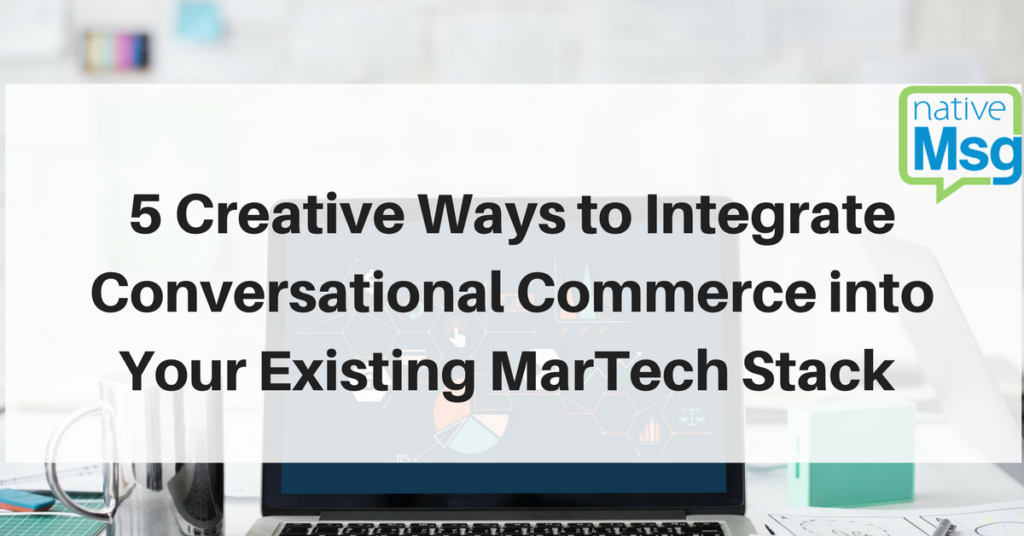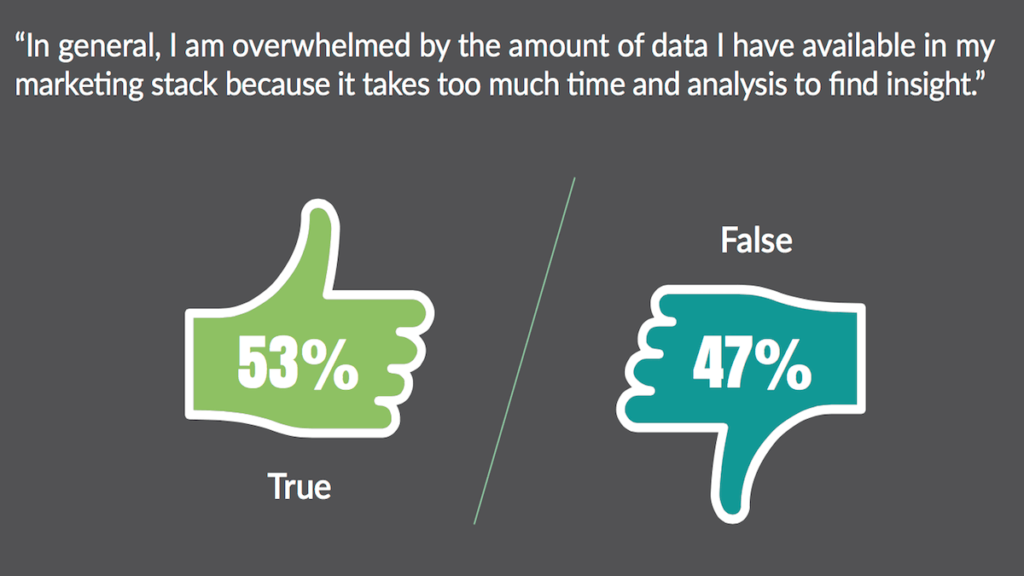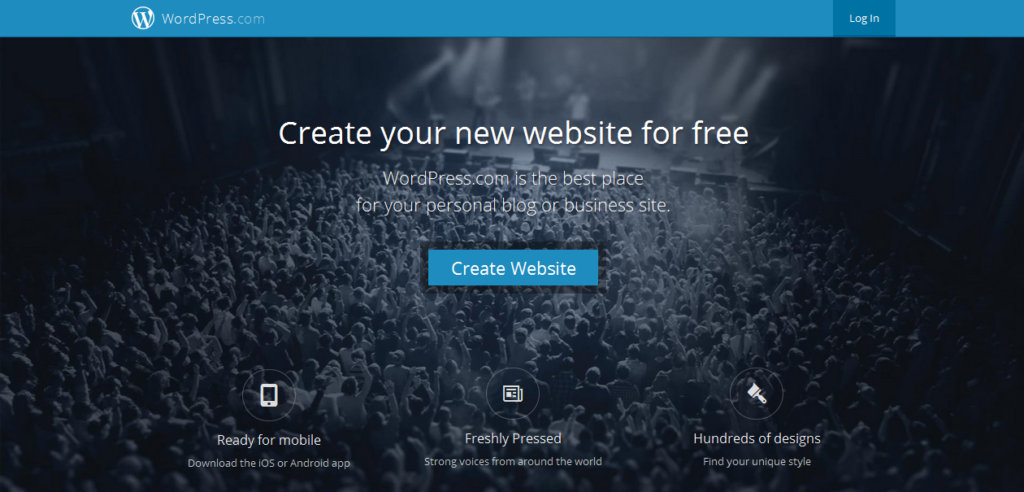
Simplify your sales funnel, decrease multi-step friction and allow consumers greater choice all within messaging apps? Sounds like a good strategy for most brands. But how do you get there from here when messaging apps aren’t universally used and the e-commerce explosion meant to occur on messaging is still gaining momentum?
There are other inroads that businesses may not consider as competitive applications for conversational commerce.
Data shows that spending on marketing technology is forecasted at $32 billion this year. Gartner’s Christopher Ross, a research director, noted in a recent Forbes piece that many companies are underutilizing the tech they already have before moving on. On the whole, businesses are also seeking ways to automate more effectively.
You can start where you are, with the tech you do have, to add a layer of conversational AI, combined with e-commerce, to your existing MarTech stack.
This piece is meant to give you a realistic approach to adding a conversational commerce component to your digital strategy, and to arm you with information about possibilities within your marketing stack to help you better manage data and spend.
Whichever vertical your business is pursuing, here are 5 creative ways to add conversational commerce to your existing stack that you may not realize.
Your Business MarTech Stack: Tech Infrastructure, Apps, Use

Much has been written about the best tech stacks, marketing stacks and languages most businesses use across industries.
The reality is, what’s best for your business, really depends on your business. While that’s a fairly general acknowledgement, in deciding on the right approach for your business, there are a few patterns that your business should note:
- Most legacy corporations and brands rely on trusted tech to build on.
- If the infrastructure is easier to use from the start, the easier it will be to maintain and the more sustainable it will be in the long run. If you’re compensating early on with the infrastructure, the stack isn’t working for your needs; if the programming language is harder to maintain, if the CMS is buggy, if you’re only using half of the features for a CRM but the cost is high, it makes sense to re-strategize sooner than later.
- When it comes to language preference, one research study revealed that 81 percent of companies valued at $1 billion or over used JavaScript, trailed by Python and Java as the next most-used languages.
What’s in Your MarTech Stack?
MarTech is tricky.
MarTech.com states that it’s marketing combined with technology (of course!). But marketing tech has one constant: it changes rapidly. and is more so a term that attempts to quantifying and qualifying the interconnected categories within digital marketing.
But don’t let the FOMO inherent in digital advancement deter you from seeing that most businesses use a combination of typical layers. It’s in these layers you can begin to add AI as conversational commerce.
- Content Management Systems
- Customer Relationship Management
- Social
- Advertising
Analytics, collaboration tools and lead tech also play major digital roles in business today. Chatbots can be integrated for internal use for gathering personalized analytics data and lead data to supporting collaboration in Slack, Teams and other dominant collaboration tools.
1. Content Management System: Embed a Chatbot on Your Company Blog

Content creation generates traffic. Whether you’re a start-up or work with major brands, content is still the best way for an audience to find you. In fact, blog posts account for 434% more indexed pages and almost 97% more indexed links, per DemandMetric. What’s more, prioritizing blogging creates 13 times more likelihood of gaining a postive ROI, reports HubSpot.
Blogging drives traffic.
Instead of a call to action in your blog post, on page or at the end of a post, embed a chatbot to lead visitors to the next steps along the funnel in considering your product or service. A chatbot engages visitors to invest further in the topic and in your brand by allowing them to pursue more personalized information.
Here’s How a Chatbot Embedded On-site Can Increase Engagement and Enhance Security: Why Embed a Chatbot on Your Website?
2. Customer Relationship Management (CRM) App: Add a Conversational Layer
Without a full-service CRM, 80% of leads get left on the table, reports Pardot. CRM software is typically the hub to align company-wide communication, process and actions as it relates to existing and new customers. But this is actually a great space to nurture leads in the decision making process.
You can add a simple Messenger chatbot to your CRM. Depending on the CRM, you can send friend requests, and product information, sales messages or news about coming releases to a lead’s Facebook account or wall. You’ll be able to speak directly with the customer through Messenger with the added benefit of an always-on sales person–your chatbot– that can then also gather additional lead information to enter into your CRM.
3. Email Marketing: Interactive Engagement to Compel Decision-Making
First, a word on email marketing: Most companies still implement this in their marketing strategy because it results in qualified leads and conversions. But in reality, that’s only because chatbot adoption is still on the curve. The fact is, chatbots create markedly higher open rates and engagement rates.
Combining email marketing with chatbot engagement is one way to increase chatbot adoption and engagement, and it is possible to integrate a chatbot within email messaging. You can do this in a few ways–either by linking a chatbot in a traditional email or by creating an email chatbot that allows you to send anything from promotions to event postcards.
4. Unchartered Social Conversational Commerce
By now, almost everyone knows you can integrate a chatbot on Facebook, Twitter, Slack and even Skype. But what about SnapChat? Currently, the social channel doesn’t support chatbots in direct messages. But it is beginning to navigate commerce and having success right away––in March of this year, Nike’s Air Jordans sold out in 23 minutes on SnapChat.
More importantly, take a look at the usage statistics :
- 400 million Snapchat stories are produced daily.
- 45% are between the ages of 18 to 24 and about 70% are 34 and younger.
- Globally, Snapchat users range between 10% of the US population to 25% in the UK and 50% in Norway.
Snapchat’s had some turbulence of late, with new design roll-outs, and erratic numbers as a result, within Snapchat Discover, but there are hints that they plan to offer commerce within Discover in the near future. This opens the door to chatbot experience in brand stores there. With strong usage statistics for the Millennial and Generation Z demographics, brands are wise to keep tabs here as Facebook halts its chatbot review program.
Whats Up with WhatsApp for automated messaging? Here’s what you need to know, now: The State of Chatbots for Business on Facebook, Twitter and WhatsApp
5. Traditional Digital Advertising Goes Conversational
A talking banner-ad, a voice-assisted ad that piggybacks off of a TV commercial, video ads that guide users to a chatbot experience? Sounds great, yes?
Actually, it’s either already available or fast on the way!
Marketers may not realize the extent of chatbot development even within the last two years. You can embed banner ads on site that are interactive. Work with conversational AI developers to create Alexa skills that will grow toward “T-commerce,” or the ability to make real-time, voice-assisted purchases during a television commercial.
Video is one of the most important tools you can use in your cadre of content. Short, easy to understand “How-to” videos with an in-video clickable CTA to a chatbot, either on Messenger or onsite, is a creative way to guide user experience and commerce.
Not only will visitors be able to take a look at your product right away, but they can garner real-time help for any questions they have or information they desire in order to move forward with a purchase.
When the market moves, business needs to move with it. Automation and responsiveness through intelligent conversational technology are disrupting business models across industries. Positioning your business with these original marketing strategies is one way to support long-term sustainability as conversational AI commands more and more business functions.
Learn how your brand can integrate a layer of conversational AI into customer service strategy with nativeMsg.
Free Trial
Get Started With RCS
Business Messaging!
Unlock the power of RCS and revolutionize your customer engagement.


